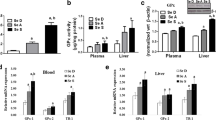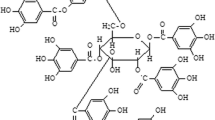Abstract
Selenium-containing amino acids, selenocystine (CysSeSeCys), methylselenocysteine (MeSeCys), and selenomethionine (SeMet) have been examined for anti-hemolytic and peroxyl radical scavenging ability. Effect of these compounds on membrane lipid peroxidation, release of hemoglobin, and loss of intracellular K+ ion as a consequence of peroxyl radicals-induced oxidation of human red blood cells were used to evaluate their anti-hemolytic ability. The peroxyl radicals were generated from thermal degradation of 2,2′-azobis(2-methylpropionamidine) dihydrochloride. Significant delay (t eff) was observed in oxidative damage in the presence of the selenium compounds. From the IC50 values for the inhibition of hemolysis, lipid peroxidation, and K+ ion leakage, the relative anti-hemolytic ability of the compounds were found to be in the order of CysSeSeCys > MeSeCys > SeMet. The anti-hemolytic abilities of the compounds, when compared with sodium selenite (Na2SeO3) under identical experimental conditions, were found to be better than Na2SeO3. Relative rate constants estimated for the reaction of MeSeCys and SeMet with peroxyl radicals by competition kinetics using ABTS2− as a reference confirmed that all the compounds are efficient peroxyl radical scavengers. Comparison of the GPx-like activity of these compounds, by NADPH–GSH reductase coupled assay, indicated that CysSeSeCys exhibits the highest activity. Based on these results, it is concluded that among the compounds examined, CysSeSeCys, possessing the ability to reduce peroxyl radicals and hydroperoxides showed efficient anti-hemolytic activity.







Similar content being viewed by others
References
Thannickal VJ, Fanburg BL (2000) Reactive oxygen species in cell signaling. Am J Physiol 279:1005–1028
Burdon RH (1995) Superoxide and hydrogen peroxide in relation to mammalian cell proliferation. Free Radic Biol Med 18:775–794
Kehrer JP (1993) Free radicals as mediators of tissue injury and disease. Crit Rev Toxicol 23:21–48
Kannan K, Jain SK (2000) Oxidative stress and apoptosis. Patho Physiol 7:153–163
Matés JM (2000) Effects of antioxidant enzymes in the molecular control of reactive oxygen species toxicology. Toxicol 153:83–104
Brenneisen P, Steinbrenner H, Sies H (2005) Selenium oxidative stress and health aspects. Mol Aspects Med 26:256–267
Willcox JK, Ash SL, Catignani GL (2004) Antioxidants and prevention of chronic disease. Crit Rev Food Sci Nutr 44:275–295
Nichter M, Thompson JJ (2006) For my wellness, not just my illness: North Americans use of dietary supplements. Cult Med Psychiatry 30:175–222
Bradburn MJ, Deeks JJ, Berlin JA et al (1996) Effects of selenium supplementation for cancer prevention in patients with carcinoma of the skin: a randomized controlled trial. JAMA 276:1957–1963
Tapiero H, Townsen DM, Tew KD (2003) The antioxidant role of selenium and selenocompounds. Biomed Pharmacother 57:134–144
Venardos K, Harrison G, Headrick J et al (2004) Effects of dietary selenium on glutathione peroxidase and thioredoxin reductase activity and recovery from cardiac ischemia–reperfusion. J Trace Elem Med Biol 18:81–88
Nordberg J, Arnér ESJ (2001) Reactive oxygen species, antioxidants, and the mammalian thioredoxin system. Free Radic Biol Med 31:1287–1312
Mugesh G, du Mont W, Sies H (2001) Chemistry of biologically important synthetic organoselenium compounds. Chem Rev 101:2125–2180
Sies H, Arteel GE (2000) Interaction of peroxynitrite with selenoproteins and glutathione peroxidase mimics. Free Radic Biol Med 28:1451–1455
Bhabak KP, Mugesh G (2007) Synthesis, characterization and antioxidant activity of some ebselen analogues. Chem Eur J 13:4594–4601
Santhosh KB, Kunwar A, Ahmad A et al (2009) In vitro radioprotection studies of organoselenium compounds: differences between mono- and diselenides. Rad Env Biophy 48:379–384
Schewe T (1995) Molecular actions of Ebselen, an anti-inflammatory antioxidant. Gen Pharmacol 26:1153–1169
Nakamuro K, Okuno T, Hasegawa T (2000) Metabolism of selenoamino acids and contribution of selenium methylation to their toxicity. J Health Sci 46:418–421
El-Sayed WM, Aboul-Fadl T, Lamb JG et al (2006) Effect of selenium containing compounds on hepatic chemoprotective enzymes in mice. Toxicol 220:179–188
Babu CK, Khanna SK, Das M (2008) Antioxidant status of erythrocytes and their response to oxidative challenge in humans with argemone oil poisoning. Toxicol Appl Pharmacol 230:304–311
Missiry EI, Abou-Seif M (2000) Photosensitization induced reactive oxygen species and oxidative damage in human erythrocytes. Cancer Lett 158:155–163
Niki E, Komuro E, Takahashi M et al (1998) Oxidative haemolysis of erythrocytes and its inhibition by free radical scavengers. J Biol Chem 263:19809–19814
Ali I, Gatasheh MKM, Naseem I (2000) Haemolysis of human red blood cells by riboflavin–Cu(II) system. Biochim Biophys Acta 1523:225–229
Tang YZ, Liu ZQ (2007) Free-radical-scavenging effect of carbazole derivatives on AAPH induced haemolysis of human erythrocytes. Bioorg Med Chem 15:1903–1913
Shui-Ling D, Wei-Feng C, Zhou B et al (2006) Protective effects of curcumin and its analogues against free radical-induced oxidative hemolysis of human red blood cells. Food Chem 98:112–119
Yoshida Y, Itoh N, Saito Y et al (2004) Application of water-soluble radical initiator, 2, 2′-azobis- [2-(2-imidazolin-2-yl)propane] dihydrochloride, to a study of oxidative stress. Free Radic Res 38:375–384
Kunwar A, Mishra B, Barik A et al (2007) 3, 3′-diselenopropionic acid an efficient peroxyl radical scavenger and a GPx mimic, protects erythrocytes (RBC) from AAPH-induced hemolysis. Chem Res Toxicol 20:1482–1487
Banerjee A, Kunwar A, Mishra B et al (2008) Concentration dependent antioxidant/pro-oxidant activity of curcumin: studies from AAPH induced hemolysis of RBCs. Chem Biol Interact 174:134–139
Kwak CS, Mun KC, Suh SI (2002) Production of oxygen free radical and hemolysis by cyclosporine. Transplant Proc 34:2654–2655
Mishra B, Priyadarsini KI, Mohan H et al (2006) Horseradish peroxidase inhibition and antioxidant activity of ebselen and related organoselenium compounds. Bioorg Med Chem Lett 16:5334–5338
Guha SN, Moorthy PN, Kishore K et al (1987) One electron reduction of thionine studied by pulse radiolysis. Proc Indian Acad Sci (Chem Sci) 99:261–271
Fielden EM (1982) Chemical dosimetry of pulsed electron and X-ray sources in the 1–20 MeV range. In: Baxendale JH, Busi F (eds) The study of fast processes and transient species by electron pulse radiolysis. D. Reidel, USA, pp 49–62
Mishra B, Barik A, Kunwar A et al (2008) Correlating the GPx activity of selenocystine derivatives with one-electron redox reactions. Phosphorus Sulfur Silicon 183:1018–1025
Packer JE, Willson RL, Bahnemann D et al (1980) Electron transfer reactions of halogenated aliphatic peroxyl radicals: measurement of absolute rate constants by pulse radiolysis. J Chem Soc Perkin Trans 2:296–299
Vissers MCM, Winterbourne CC (1995) Oxidation of intracellular glutathione after exposure of human red blood cells to hypochlorous acid. Biochem J 37:57–62
Vivancos M, Moreno JJ (2005) β-Sitosterol modulates antioxidant enzyme response in RAW 264.7 macrophages. Free Radic Biol Med 39:91–97
Wolfenden BS, Willson RL (1982) Radical-cations as reference chromogens in kinetic studies of one-electron transfer reactions: pulse radiolysis studies of 2, 2′-azinobis-(3-ethylbenzthiazoline-6-sulphonate). J Chem Soc Perkin Trans 2:805–812
Acknowledgments
The authors are thankful to Dr. Arunachalam, Head CCCM, Hyderabad for help in flame photometry experiment and Dr. T Mukherjee and Dr. S. K. Sarkar for the encouragement and support.
Author information
Authors and Affiliations
Corresponding author
Rights and permissions
About this article
Cite this article
Kumar, B.S., Kunwar, A., Singh, B.G. et al. Anti-hemolytic and Peroxyl Radical Scavenging Activity of Organoselenium Compounds: An In Vitro Study. Biol Trace Elem Res 140, 127–138 (2011). https://doi.org/10.1007/s12011-010-8692-3
Received:
Accepted:
Published:
Issue Date:
DOI: https://doi.org/10.1007/s12011-010-8692-3




